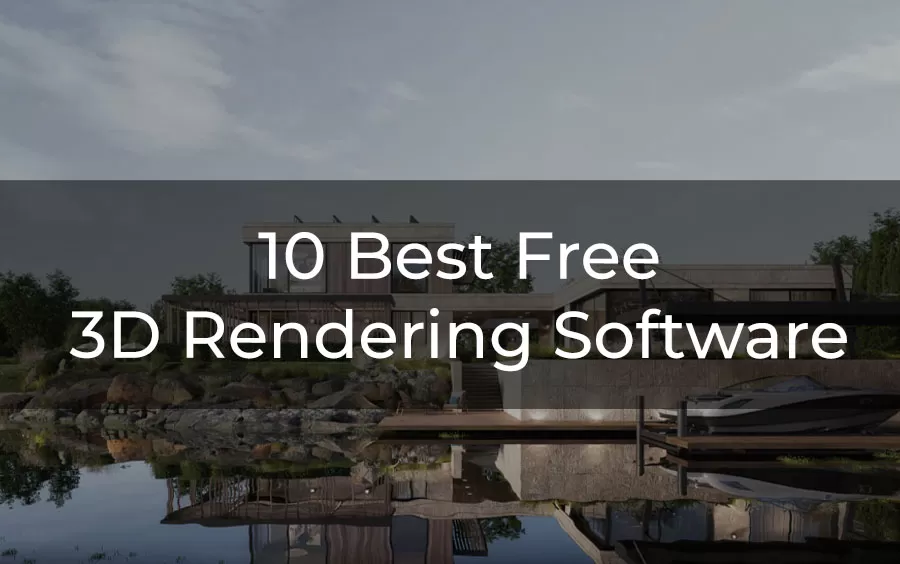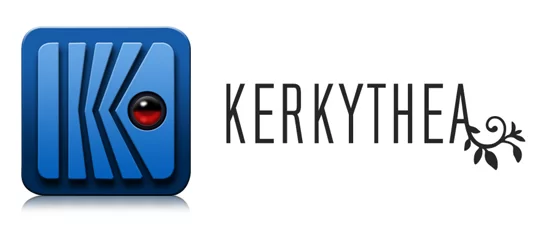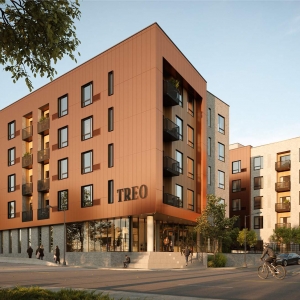10 Best Free 3D Rendering Software 2023
3D rendering may seem straightforward, but in reality, it’s a complex field that requires a deep understanding of 3D software. Mastering these tools to produce high-quality content can be a challenging task.
With over ten years of experience as a 3D studio, we have explored various rendering programs and have curated a list of some of the finest free options in the visualization and 3D rendering software market. While there are paid options available, this guide will focus on 10 of the best free rendering programs, including trial versions, so that your only investment is your time and effort.

What is 3D Rendering?
3D rendering refers to the technique of generating images from 3D models, which are constructed based on specific designs. In the architectural domain, these models often represent buildings and interiors, and they are crafted before the actual construction commences, serving various functions.
This entire procedure is executed using specialized 3D rendering software, available in numerous varieties. The resulting images can portray a design with striking realism, as all the 3D components are adorned with textures that mimic physical materials. Additionally, these images can be illuminated to resemble real-world lighting conditions.
3D renderings are generally categorized into two main types – exterior renderings and interior renderings. Interestingly, the same software can be utilized to produce both kinds.
The quality of the final product is heavily influenced by the individual abilities of the 3D artist or the 3D rendering company responsible for creating the visual content. The choice of software also plays a significant role in determining the outcome.
-
1.Blender

In my opinion, Blender stands out as a premier free rendering software in the fields of 3D design and graphic animation. As an open-source 3D creation suite, it’s not only free but also supported by a rapidly expanding community of animators, multimedia artists, educators, students, scientists, and other professionals. This community-driven approach ensures that Blender receives frequent updates, new features, bug fixes, and usability enhancements, outpacing traditional 3D design software.
The Blender platform is both intuitive and packed with features. It offers comprehensive support for the entire 3D pipeline, encompassing everything from sculpting, visual effects, rigging, and virtual reality to simulation, 3D renderings, motion tracking, video editing, and 2D and 3D architectural animation.
Blender’s extensive collection of tools, plugins, and functionalities might present a challenging learning curve for newcomers. However, the abundance of online educational materials makes this free rendering software more accessible than it might initially seem.
Pros:
- ● Entirely Free
- ● Supports the full 3D modeling and animation pipeline
- ● Regularly updated by the Blender community
- ● Abundant online learning resources
- ● Thriving online community
- ● Equipped with powerful renderers (Eevee and Cycles)
- ● Offers a wide array of add-on options
- ● Features quality animation, video editing, and other interactive 3D applications
Cons:
- ● The steep initial learning curve
- ● Generalist tool, lacking specialization in specific tasks, unlike other specialized software
- ● Not considered an industry-standard tool
- ● Limited external support (e.g., external renders) for certain aspects of its pipeline
- ● Potentially overwhelming cluttered menu panels and toolbars for new learners
- ● Workflow and interface may require time to learn and customize
Blender’s blend of powerful features and community-driven development makes it a unique and valuable tool in the 3D rendering space, despite some challenges that may face new users.
-
2. Cycles Render
 Cycles is a state-of-the-art rendering engine that has become a preferred alternative to native renderers in Blender, as well as in other premium 3D rendering software like Poser or Rhino. Since its inception, this path-tracing render engine has earned a reputation and widespread recognition across artists, studios, and the entire animation sector.
Cycles is a state-of-the-art rendering engine that has become a preferred alternative to native renderers in Blender, as well as in other premium 3D rendering software like Poser or Rhino. Since its inception, this path-tracing render engine has earned a reputation and widespread recognition across artists, studios, and the entire animation sector.
As a typical feature of Blender applications, Cycles is an open-source platform that is highly engaging, frequently updated, well-maintained, and packed with an astonishing array of rendering capabilities. Among its offerings are robust subsurface scattering, precise PBR shading nodes, and solutions like vector displacement and adaptive subdivision, all of which empower Blender users to craft realistic renderings with true-to-life illumination and computations.
Pros:
- ● A beginner-friendly rendering program
- ● Sleek, interactive, and user-centric interface
- ● Ideal for animation projects
- ● Houses an array of remarkable rendering features while remaining accessible
- ● Equipped with tools like support for caustics and cryptomatte, along with potent OIDN and OptiX denoisers
- ● Known for producing highly photorealistic outcomes, making it a top choice for realistic rendering
- ● Features straightforward settings and workflows for efficient and visually appealing renders
- ● Integrates with Blender’s node-based materials system, offering more flexibility and customization than other renderers like Vray
- ● Includes the OptiX-powered rendering engine, contributing to its status as an incredibly rapid path-tracer
- ● Ensures accurate lighting calculations within Cycles
Cons:
- ● Cycles prioritizes realism at the expense of render speed and viewpoint efficiency.
- ● Encounters noisy imagery while rotating or navigating through a scene.
- ● Known for extended render times.
- ● Nodes are cluttered with many redundant options.
- ● Light grouping functionality is subpar within Cycles.
- ● Caustics accuracy falls short compared to other rendering engines like V-Ray and Arnold.
- ● GPU lacks support for volume rendering and subsurface scattering.
- ● Not recognized as an industry standard, mainly appealing to hobbyists, freelancers, beginners, and smaller studios.
-
3. Enscape (Trial)

Enscape is a 3D rendering software that offers a free 14 days trial, used for creating real-time rendering and virtual reality videos, images, and interactive apps. The plugin integrates into modeling software like SketchUp, Vectorworks, ArchiCAD, Revit, and Rhinoceros 3D and helps users turn their 3D models into realistic, immersive 3D experiences. Enscape is used by architecture firms and professionals in the construction and engineering fields. The main strength of this application lies in producing realistic visualizations of scenes with minimal operating complexity. Further, it empowers design workflows by seamlessly integrating product/data visualization and design methods into one process.
Pros:
- ● Simplifies the creation of appealing renders.
- ● Operates efficiently without the need for a high-capacity PC.
- ● Exhibits strong compatibility with SketchUp.
- ● Incorporates ray tracing, enhancing reflections and realism.
- ● Offers an immediate real-time review of all modifications.
- ● Boasts reduced render times.
- ● Provides the quickest and most straightforward method to convert building models into stunning, interactive VR walkthrough experiences.
- ● Demands no prior specialized programming knowledge for usage.
- ● Enables users to design and visualize alterations concurrently within their Enscape design model.
Cons:
- ● Limited to a 14-day free trial, with payment required thereafter.
- ● Lacks options for 360˚ batch renderings and animations.
- ● Suffers from subpar rendering quality.
- ● Struggles with exposure determination in 360˚ panoramic images.
- ● Prone to producing images that are either underexposed or overexposed.
- ● VR experiences on web browsers are plagued by lag and diminished quality compared to offline renderings.
- ● Frequent texture issues, as the software struggles to read relative paths.
4.LuxCoreRender
 LuxCoreRender, originally launched in 2008 as “LuxRender,” is a fully free, physically-based, unbiased 3D rendering engine. In 2017, the project underwent a significant reboot, including a name change to LuxCoreRender, and substantial enhancements to the software’s rendering speed.
LuxCoreRender, originally launched in 2008 as “LuxRender,” is a fully free, physically-based, unbiased 3D rendering engine. In 2017, the project underwent a significant reboot, including a name change to LuxCoreRender, and substantial enhancements to the software’s rendering speed.
Similar to Cycles, LuxCoreRender operates as a rendering program within Blender and shares the open-source nature. This allows users to tailor settings such as mood and light balance in scenes to meet specific requirements.
Utilizing the physically based rendering (PBR) model, LuxCoreRender aims to mimic real-world light flow. This approach ensures that the final images produced by LuxCoreRender closely resemble actual photographs.
Pros:
- ● Rapid caustics and effective synthesis of scenes with numerous light sources.
- ● The PBR system imparts a convincing photorealistic appearance to the final images.
- ● Highly customizable to suit individual needs.
- ● Supports GPU rendering on Macs, a feature not found in Cycles.
- ● Functions as a standalone render software and integrates with various 3D programs, including Blender, Max, Cinema 4d, Maya, 3ds Max, Sketchup, and more.
Cons:
- ● As with many open-source platforms, users may encounter bugs.
- ● Not considered an industry standard.
- ● The abundance of features can be overwhelming for newcomers.
- ● Slower scene export compared to Cycles.
- ● Lacks essential options for specific workflows, such as character animation.
5.Verge 3D
 Verge3D is a dynamic real-time rendering toolkit, designed to craft immersive and adaptable 3D experiences directly within web browsers. This versatile add-on is compatible with a wide array of platforms and software, such as Blender, Maya, Modo, Autodesk 3ds Max, Microsoft Paint 3D, Marmoset Toolbag, Sketchfab, Facebook, and Microsoft Remix 3D. I’d like to mention, that we have never implemented it within Freedes studio.
Verge3D is a dynamic real-time rendering toolkit, designed to craft immersive and adaptable 3D experiences directly within web browsers. This versatile add-on is compatible with a wide array of platforms and software, such as Blender, Maya, Modo, Autodesk 3ds Max, Microsoft Paint 3D, Marmoset Toolbag, Sketchfab, Facebook, and Microsoft Remix 3D. I’d like to mention, that we have never implemented it within Freedes studio.
One of its standout features is the Puzzles option, a user-friendly visual scripting environment. Even those without coding expertise can effortlessly create interactive scenes through a simple drag-and-drop method. Verge3D opens the door to constructing a variety of engaging online content, including presentations for websites, portfolios, e-commerce platforms, advertisements, AR/VR games, and educational materials.
Pros:
- ● Available for free for educational or evaluation purposes.
- ● Delivers high-quality, photo-realistic images.
- ● Supports various animation styles.
- ● Features an optimized asset loading format.
- ● Includes the Puzzles editor for no-code development.
- ● Recognized as the top interactive 3D web application for non-programmers.
- ● Offers seamless cross-platform interoperability.
Cons:
- ● Commercial projects require a paid license.
- ● Designs remain inactive until a license is acquired.
- ● Some operations, such as adding lens flare, are not possible within the Puzzle editor and demand coding skills.
- ● Challenges with camera scaling.
- ● Inefficiencies in raycasting of skinned objects.
6. Kerkythea

Kerkythea operates as an independent rendering engine, specializing in transforming 3D graphics into realistic and vivid renders. Available as freeware, this 3D rendering software is equipped with intriguing features, including ray tracing, metropolis light transport (MLT), authentic lighting, and materials that adhere to physical properties.
The engine’s adaptability allows it to integrate smoothly with any software capable of exporting files in 3DS, OBJ, SIA (silo), and XML formats. Kerkythea is commonly utilized with platforms like SketchUp, Blender, 3D Max, Wings3D, Silo, and Silo.
Pros:
- ● Completely free for both educational and commercial usage.
- ● Capable of producing quality renders.
- ● Offers robust, flexible, and e-learning tools.
- ● Provides materials of accurate and superior quality.
- ● Harmonizes well with popular architectural software such as SketchUp.
Cons:
- ● Premium alternatives like V-ray outpace Kerkythea in rendering speed.
- ● Presents a challenging learning curve for newcomers.
- ● Overwhelms users with an extensive array of tools, settings, shapes, textures, features, materials, environments, and techniques.
- ● Suffers from an unattractive and non-user-friendly interface.
- ● Material adjustments can be complex and time-consuming to learn.
- ● Exhibits varying compatibility levels with different software, favoring some (e.g., SketchUp and Max) over others.
- ● Struggles with slow rendering speed, particularly on older computer models.
-
7. Houdini Apprentice
 Houdini Apprentice serves as a 3D procedural tool, tailored to support students, enthusiasts, and learners in crafting visual effects (VFX) for movies and video games. This free demo version of the renowned animation software, Houdini FX, is exclusively for educational use, enabling users to create 3D models and an array of special effects such as simulations, intricate reflections, particle systems, and various 3D animations.
Houdini Apprentice serves as a 3D procedural tool, tailored to support students, enthusiasts, and learners in crafting visual effects (VFX) for movies and video games. This free demo version of the renowned animation software, Houdini FX, is exclusively for educational use, enabling users to create 3D models and an array of special effects such as simulations, intricate reflections, particle systems, and various 3D animations.
Recognizing the substantial cost of the full-fledged Houdini FX, the developers introduced Houdini Apprentice as a complimentary offering. This allows aspiring designers to explore and learn the software’s fascinating features without financial commitment.
Houdini Apprentice employs techniques like texturing, digital mesh modification, deformable geometry, and swift multi-layer image animation to achieve its unique effects. These capabilities contribute to the stunning outcomes of Houdini projects, earning the application acclaim among VFX giants like Sony Pictures and Walt Disney.
Pros:
- ● Available for free for evaluation or educational use.
- ● While new users may face an initial learning curve, ample tutorials and guides are provided.
- ● Introduction of modernized modeling tools for more straightforward poly modeling.
- ● Significant enhancements to the surface shader system.
- ● Inclusion of new viscous fluid shelf tools.
- ● Addition of innovative tools like onion skinning and crowd ragdolls for improved animation.
Cons:
- ● Not suitable for commercial endeavors.
- ● Mastery of the looping system may be time-consuming.
- ● Transitioning from local variables to object attributes may confuse novices.
- ● Incompatibility with third-party rendering engines; uses a proprietary file format.
- ● Rendering is confined to a resolution of 1280×720.
- ● Restrictions on rendering files to specific formats, with word markings applied.
-
8. Daz 3D

Daz 3D stands as a multifaceted media design tool, specializing in the creation of 3D scenes and renders. Widely favored by illustrators and animators, it offers a range of functionalities, from 3D animation and rendering to figure posing. This complimentary 3D rendering software integrates various add-ons and design platforms, including Daz Studio, Hexagon, and Genesis 8, to craft rigged, realistic human characters in three dimensions.
Pros:
- ● Available as free rendering software.
- ● Boasts a user-friendly and highly customizable interface.
- ● Features advanced platforms like Genesis for crafting unique scenes and characters.
- ● Genesis tool offers morphing functions to dress characters and shape body figures with diverse sizes and muscularity.
- ● Includes the Hexagon application, enhancing accessibility for beginners to the robust features of Daz 3D.
- ● Offers abundant tutorials for learning 3D image creation and animation.
- ● Provides online forums and technical support for users.
- ● Comes pre-installed with numerous additional applications.
- ● Compatible with the latest versions of Mac and Windows.
Cons:
- ● Posing controls within the animation tool can be challenging to manage.
- ● Installation may prove technical for newcomers.
- ● Online discussion forums could benefit from more user-friendly content.
- ● Daz Studio exhibits compatibility issues with the UNIX partition of Mac OS X.
-
9. Wings 3D
 Wings 3D is a complimentary 3D rendering software, designed to model and texture low to mid-range polygon models for games and animated films. Lacking support for animated GIFs and videos, it offers only basic OpenGL rendering functionality. Consequently, Wings 3D is often paired with specialized rendering applications like Blender to enhance rendering and animation capabilities.
Wings 3D is a complimentary 3D rendering software, designed to model and texture low to mid-range polygon models for games and animated films. Lacking support for animated GIFs and videos, it offers only basic OpenGL rendering functionality. Consequently, Wings 3D is often paired with specialized rendering applications like Blender to enhance rendering and animation capabilities.
Categorized as an advanced subdivision modeler, Wings 3D is compatible with Windows, Linux, and Mac operating systems. Its texture mapping abilities contribute to more lifelike graphics, and designers can export documents in all standard file formats.
Pros:
- ● Entirely free, swift, and cross-platform.
- ● Intuitive on-screen buttons make the interface easy to understand.
- ● Straightforward drag-and-drop system enhances usability.
- ● Simplified program structure facilitates core control over 3D functions.
- ● Equipped with nearly all essential tools for low-poly modeling.
- ● Supports export and import in almost all formats.
- ● Sculpting features enable the creation of more detailed models.
- ● 3D models print effectively.
Cons:
- ● Lacks support for animation and rendering, requiring additional software.
- ● Certain menu features, like spiral and torus knots, may pose printing challenges.
- ● Documentation is rudimentary and limited.
- ● Infrequent software updates.
- ● Potential complexity for newcomers.
- ● Initial learning curve may be steep before mastering software features.
-
10. 5D Render

5D render is an advanced visualization technique that goes beyond traditional 3D rendering by incorporating time and cost as additional dimensions. This innovative approach is particularly valuable in construction and architectural projects, where it enables stakeholders to visualize not only the spatial aspects of a design but also its construction timeline and associated costs.
By integrating 3D models with scheduling and budgeting data, 5D render provides a comprehensive view of a project, allowing for more informed decision-making and efficient resource allocation. It’s a tool that bridges the gap between design, construction, and project management, fostering collaboration and reducing uncertainties.
Pros:
- ● Offers a holistic view of a project, combining spatial, temporal, and financial dimensions.
- ● Enhances collaboration between designers, constructors, and project managers.
- ● Facilitates more accurate budgeting and scheduling.
- ● Enables scenario analysis, allowing stakeholders to explore different design and construction options.
- ● Supports sustainable design by enabling the analysis of energy efficiency and other sustainability metrics.
- ● Can be integrated with Building Information Modeling (BIM) for even more robust project visualization and management.
- ● Reduces risks by identifying potential issues early in the design process.
Cons:
- ● Requires specialized software and expertise, potentially increasing initial costs.
- ● Integration with existing workflows and systems may be challenging.
- ● The accuracy of the 5D render depends on the quality and completeness of the input data.
- ● May be perceived as complex and overwhelming, particularly for smaller projects.
- ● Ongoing maintenance of the 5D render (e.g., updating schedules and costs) can be time-consuming.
-
Conclusion
Free rendering software offers a diverse range of options for artists, designers, and hobbyists. Tools like Wings 3D, Daz 3D, Houdini Apprentice, and Kerkythea each provide unique functionalities, from character creation to lifelike rendering. While these platforms democratize 3D design by being accessible to all, they may have limitations such as compatibility issues or lack of advanced features. Nevertheless, the availability of free rendering software encourages experimentation and learning, opening doors for creativity and innovation. If you need assistance in choosing the right tool, feel free to reach out to one of our project managers (info@freedesstudio.com), and we will guide you. Whether for professional use or personal exploration, these tools provide valuable opportunities in the ever-evolving field of 3D visualization, making them an essential resource for many.





